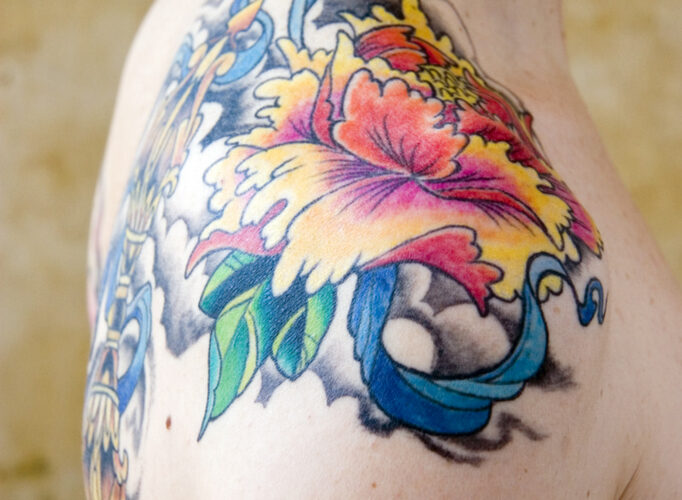Tattoos for Gamblers

In the recent past, the social impression of body modification was negative, scathing and scared. It would seem nowadays, since at least the beginning of the 21st Century – arguably stretching into the decade before – that this practice has become far more commonplace and can even pass unnoticed in most spheres of society. So for those interested in researching how behaviours and attitudes change, this period has brought forth a wealth of new ideas and more importantly new studies. This research needs to be considered in the context of how we view those who choose to alter their appearances in such ways, along with the ever present question of what about this information that we are gathering can be used in real life.
Although frequently studied together, the following will only discuss tattoo prevalence and the impact of tattoos as opposed to the more general term of body modification – which includes piercings, etc. None of the figures used will relate to this general term.
The other important distinction to make is that of the common-sense and the analytical understandings of the term “risk-taking behaviour”. Although this can refer to a wide range of behaviour in everyday usage, in the research from which this article has drawn1 it is confined to acts of substance abuse, school absences, gang affiliations, gambling, disordered eating, sexual behaviour among adolescents, crime and suicide attempts. It is important to note that none of these studies consider the act of getting a tattoo, in and of itself, “risk-taking behaviour”.
To begin, the easiest question to ask seems to be: do we discriminate for or against a person due to the sight of tattoos on their body? While the statistics show a peak of 35%2 of those between 14-25 years old having at least one tattoo, it would seem when a member of society sees those with body art such as this, their reaction may still be negative.
Swami and Furnham3 conducted a study to this effect with undergraduates from two universities in the United Kingdom. After rating the appearance of depictions of women with either black or blonde hair, and either no tattoo or a tattoo on their ankle, hip or shoulder (plus combinations of the three), the results gathered showed a significant decrease in perceived physical attractiveness; an increase in the presumed sexual promiscuity of the woman; and an increase in their presumed alcohol consumption proportionate to the amount of tattoos on show. While this study has the limitation of having unrealistic stimuli – the pictures of the woman were cartoon-like and did not represent the look of a physical person – and the issue of not giving an equal account of the participants’ impression of male body art, the results still seem to point to this element of society being seen as different in a significant and overall negative way.
Similar studies5. This study seems to have such a wide influence, in part, due to its large scope for generalisation to the wider population. However, the group taken into consideration is a rather specific subset of society – those whose parents are in the military. An article published in the same journal6 identified this population – the children of military personnel – to be susceptible to multiple stressors which could lead to emotional difficulties. With this in mind, the results found may show significance in the world of those directly affected – and for this it should be commended – but does not lay down a viable case for the wider society.
However, this sentiment was clearly felt by Deschesnes et al. when they published a similar study, this time using high school students from 23 schools in Outaouais, Canada. The results here – after studying substance abuse, gang affiliation, school truancy, illegal activities, gambling and rave attendance – demonstrated that a significant number of those with tattoos were also likely to abuse illegal substances – and that this was true across both genders. With girls, tattoos were also linked to rave attendance and with boys more illegal acts in the last year were committed again among those with tattoos.
This is undeniably an issue which needs to be studied in further depth, and issues for which the causal link must be established – as it is unlikely to be the case that risk-taking behaviour, in the sense outlined above, causes tattoos and even less likely to be the other way round. In Deschesnes et al.’s study it is put forward that a female who has abused drugs is fourteen times more likely to have a tattoo than one who has not, and this statistic is in no way insignificant.
It is important to note that, even at the end of the very study which makes these claims, there is a caveat which should be taken into account. Deschesnes et al. leave the reader with this note on limitations:
“… in spite of the significant association which exists between these phenomena, the presence of tattoos… in an adolescent does not necessarily mean that he or she adopts risk-taking behaviours in other areas.”
In conclusion, the studies conducted from the beginning of the last decade seem to point to a connection between tattoos and behaviours society would benefit from losing[lref id=1][lref id=2]. Where the future research must begin is in determining why tattoos have the stigma they do, and why this connection has formed between those with risk-taking behaviour issues and this particular area of body-art. The above studies agree on one point at least, it seems to be that the information gathered here can be used to good effect when screening adolescents for issues such as suicidal tendencies and substance abuse. For this purpose, the tattoos can act as indicators for doctors to be slightly more vigilant on issues of risk-taking behaviour until further research can enlighten the scientific and medical communities with more information on the subject.
References
- Carroll, S. T., Riffenburg, R. H., Roberts T. A. & Myhre, E. B. Tattoos and Body Piercings as Indicators of Adolescent Risk-Taking Behaviours. Pediatrics. 2002
- Stieger, S., Pietschnig, J., Kastner, C. K., Voracek M. & Swami, V. Prevalence and acceptance of and piercings: A survey of young adults from the southern German-speaking area of central Europe. Perception and Motor Skills. 2010
- Swami V. & Furnham, A. Unattractive, promiscuous and heavy drinkers: Perceptions of women with tattoos. Body Image. 2007
- Degelman D. & Price, N. D. Tattoos and ratings of personal characteristics. Psychological reports. 2002. As well as, Seiter J. S. & Hatch, S. Effect of tattoos on perceptions of credibility and attractiveness. Psychological Reports. 2005. [/notes] have shown similar effects when the stimuli were rated based on credibility, intelligence, athletic and artistic ability, motivation, and generosity. All of these were shown to be better descriptions of those without tattoos, when compared to those with tattoos, by the participants.

Image Credit: Kaysha via Flickr ( License )
The question of whether we see those with tattoos differently may be the most intuitive to ask, but a more important question would be: why do we see those with tattoos differently? Starting with an influential 2002 paper by Carroll and colleagues, the correlation between adolescents having tattoos and the likelihood of them indulging in risk-taking behaviour (drug use, sexual behaviour, gang affiliation, suicide and eating disorders) has been widely cited in 21st Century writings on body modification4 Mayers, L. B. & Chiffriller, S. H. Body Art (Body Piercing and Tattooing) among Undergraduate University Students: “Then and Now”. Journal of Adolescent Health. 2008
- Chandra, A., Lara-Cinisomo, S., Jaycox, L. H., Tanielian, T., Burns, R. M., Ruder T. & Han, B. Children on the Homefront: The Experience of Children From Military Families. Pedeatrics. 2010










